| Djuma, South Africa: Search of the Bush Baby |
| If you're looking for wild, there's no wilder place than Africa, and this week's adventure brought me to the incredible Djuma Wildlife Preserve in South Africa. At Djuma, over two million acres are filled with an incredible array of wild animals. As soon as I got out of my single-engine propeller plane, I spotted a warthog, the same animal that stars in "The Lion King"! |
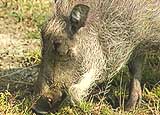 |
The warthog is named for sets of warts on its muzzle. The female has one set, the male two. But I also noted the fierce tusks of the warthog. They become razor-sharp as the creature gets older, and are a great defense. |
| I was joined by my friend and guide, Dixon, who brought his jeep to help me find our feature creature, the bush baby. Dixon had me sit in the tracker seat, literally a seat on the hood of the jeep, to help spot animals. From here, we quickly spotted a white rhino. I got off the hood and crept close, but not too close. The white rhino is named for its wide lip -- it's not white at all. |
| The rhino looks like a tank, but it's closely related to the horse. But even as I crept close I realized that it could start to charge at 35 miles an hour, and Dixon and I could be in trouble. When the rhino's ears perked up, we quickly headed back to the jeep. |
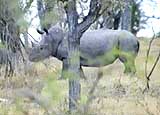 |
| Further along, we saw a herd of cape buffalo. These animals look gentle, but they're very territorial and will attack at the slightest provocation. |
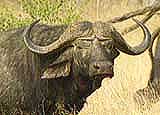 |
Some people think that they're the most dangerous animals in South Africa. Survival in these grasslands during winter can be a challenge. The water holes start drying up, more animals gather together, and the hunting grows easier for predators like the lions and the hyena. |
| Once I looked like a bush, I was able to creep close to the water hole and see the water bucks as well as the vervet monkeys who scrambled down from nearby trees. |
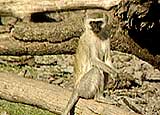 |
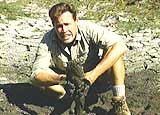 |
As winter continues, the water holes dry up leaving a cracked, dry bed behind. The barbel fish, which is like a catfish, uses its flippers like limbs to literally walk away from the dry hole to water. |
| Speaking of great adaptations, I spotted some giraffe nearby. Their long necks allow them to get food that no other animal can reach. And their spots provide great camouflage. |
| There's real danger in this preserve, like the Egyptian cobra I found. This snake's venom is so deadly a single bite could shut down your nervous system. But the cobra also gives a warning -- it exposes its hood just before striking. |
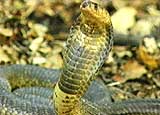 |
| As it got late, I stopped and made camp. That gave me a chance to build a campfire with some lead wood. The ash of lead wood has an interesting use: Just grab a twig of the magic waribush, chew one end until it gets fibrous, and then use the white ashlike toothpaste. Just make sure you have something to rinse with -- it doesn't taste very good! |
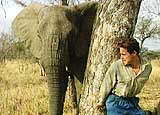 |
The next morning I had a close encounter with a bull African elephant. The big animal came right up to the tree that I was hiding behind. If it had wanted to, it could have knocked the tree right over! |
| People sometimes wonder why elephants have so many wrinkles. Well, they use all that wrinkled skin to perspire and keep cool. Without it, the elephant would get too hot to move.
I had to find the bush baby at night, since it's a nocturnal animal. And when I finally caught one it looked startled. Its big eyes give it 180-degree stereoscopic vision, perfect for seeing at night.
|
| The bush baby looks like it might belong in the squirrel family, but it's a primate. It uses its spring-like legs to leap up to seven meters, hopping from tree to tree searching for insects. When it finds an insect, it grabs it with its almost human-like fingers. |
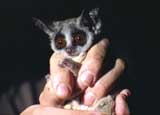 |
| There are so many animals to explore in South Africa we could stay here for months. But it's time for me to head out to my next destination. Hope you join me there! |
|
|
Totally wild,
Jeff
|